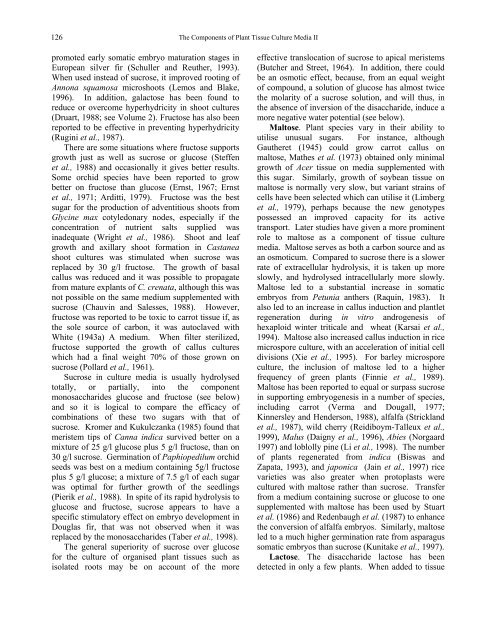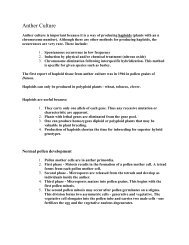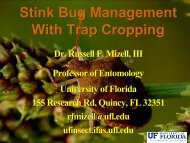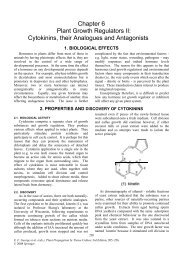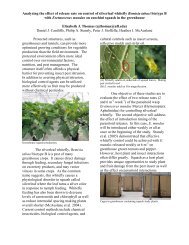The Components of Plant Tissue Culture Media II - Horticultural ...
The Components of Plant Tissue Culture Media II - Horticultural ...
The Components of Plant Tissue Culture Media II - Horticultural ...
You also want an ePaper? Increase the reach of your titles
YUMPU automatically turns print PDFs into web optimized ePapers that Google loves.
126 <strong>The</strong> <strong>Components</strong> <strong>of</strong> <strong>Plant</strong> <strong>Tissue</strong> <strong>Culture</strong> <strong>Media</strong> <strong>II</strong><br />
promoted early somatic embryo maturation stages in<br />
European silver fir (Schuller and Reuther, 1993).<br />
When used instead <strong>of</strong> sucrose, it improved rooting <strong>of</strong><br />
Annona squamosa microshoots (Lemos and Blake,<br />
1996). In addition, galactose has been found to<br />
reduce or overcome hyperhydricity in shoot cultures<br />
(Druart, 1988; see Volume 2). Fructose has also been<br />
reported to be effective in preventing hyperhydricity<br />
(Rugini et al., 1987).<br />
<strong>The</strong>re are some situations where fructose supports<br />
growth just as well as sucrose or glucose (Steffen<br />
et al., 1988) and occasionally it gives better results.<br />
Some orchid species have been reported to grow<br />
better on fructose than glucose (Ernst, 1967; Ernst<br />
et al., 1971; Arditti, 1979). Fructose was the best<br />
sugar for the production <strong>of</strong> adventitious shoots from<br />
Glycine max cotyledonary nodes, especially if the<br />
concentration <strong>of</strong> nutrient salts supplied was<br />
inadequate (Wright et al., 1986). Shoot and leaf<br />
growth and axillary shoot formation in Castanea<br />
shoot cultures was stimulated when sucrose was<br />
replaced by 30 g/l fructose. <strong>The</strong> growth <strong>of</strong> basal<br />
callus was reduced and it was possible to propagate<br />
from mature explants <strong>of</strong> C. crenata, although this was<br />
not possible on the same medium supplemented with<br />
sucrose (Chauvin and Salesses, 1988). However,<br />
fructose was reported to be toxic to carrot tissue if, as<br />
the sole source <strong>of</strong> carbon, it was autoclaved with<br />
White (1943a) A medium. When filter sterilized,<br />
fructose supported the growth <strong>of</strong> callus cultures<br />
which had a final weight 70% <strong>of</strong> those grown on<br />
sucrose (Pollard et al., 1961).<br />
Sucrose in culture media is usually hydrolysed<br />
totally, or partially, into the component<br />
monosaccharides glucose and fructose (see below)<br />
and so it is logical to compare the efficacy <strong>of</strong><br />
combinations <strong>of</strong> these two sugars with that <strong>of</strong><br />
sucrose. Kromer and Kukulczanka (1985) found that<br />
meristem tips <strong>of</strong> Canna indica survived better on a<br />
mixture <strong>of</strong> 25 g/l glucose plus 5 g/l fructose, than on<br />
30 g/l sucrose. Germination <strong>of</strong> Paphiopedilum orchid<br />
seeds was best on a medium containing 5g/l fructose<br />
plus 5 g/l glucose; a mixture <strong>of</strong> 7.5 g/l <strong>of</strong> each sugar<br />
was optimal for further growth <strong>of</strong> the seedlings<br />
(Pierik et al., 1988). In spite <strong>of</strong> its rapid hydrolysis to<br />
glucose and fructose, sucrose appears to have a<br />
specific stimulatory effect on embryo development in<br />
Douglas fir, that was not observed when it was<br />
replaced by the monosaccharides (Taber et al., 1998).<br />
<strong>The</strong> general superiority <strong>of</strong> sucrose over glucose<br />
for the culture <strong>of</strong> organised plant tissues such as<br />
isolated roots may be on account <strong>of</strong> the more<br />
effective translocation <strong>of</strong> sucrose to apical meristems<br />
(Butcher and Street, 1964). In addition, there could<br />
be an osmotic effect, because, from an equal weight<br />
<strong>of</strong> compound, a solution <strong>of</strong> glucose has almost twice<br />
the molarity <strong>of</strong> a sucrose solution, and will thus, in<br />
the absence <strong>of</strong> inversion <strong>of</strong> the disaccharide, induce a<br />
more negative water potential (see below).<br />
Maltose. <strong>Plant</strong> species vary in their ability to<br />
utilise unusual sugars. For instance, although<br />
Gautheret (1945) could grow carrot callus on<br />
maltose, Mathes et al. (1973) obtained only minimal<br />
growth <strong>of</strong> Acer tissue on media supplemented with<br />
this sugar. Similarly, growth <strong>of</strong> soybean tissue on<br />
maltose is normally very slow, but variant strains <strong>of</strong><br />
cells have been selected which can utilise it (Limberg<br />
et al., 1979), perhaps because the new genotypes<br />
possessed an improved capacity for its active<br />
transport. Later studies have given a more prominent<br />
role to maltose as a component <strong>of</strong> tissue culture<br />
media. Maltose serves as both a carbon source and as<br />
an osmoticum. Compared to sucrose there is a slower<br />
rate <strong>of</strong> extracellular hydrolysis, it is taken up more<br />
slowly, and hydrolysed intracellularly more slowly.<br />
Maltose led to a substantial increase in somatic<br />
embryos from Petunia anthers (Raquin, 1983). It<br />
also led to an increase in callus induction and plantlet<br />
regeneration during in vitro androgenesis <strong>of</strong><br />
hexaploid winter triticale and wheat (Karsai et al.,<br />
1994). Maltose also increased callus induction in rice<br />
microspore culture, with an acceleration <strong>of</strong> initial cell<br />
divisions (Xie et al., 1995). For barley microspore<br />
culture, the inclusion <strong>of</strong> maltose led to a higher<br />
frequency <strong>of</strong> green plants (Finnie et al., 1989).<br />
Maltose has been reported to equal or surpass sucrose<br />
in supporting embryogenesis in a number <strong>of</strong> species,<br />
including carrot (Verma and Dougall, 1977;<br />
Kinnersley and Henderson, 1988), alfalfa (Strickland<br />
et al., 1987), wild cherry (Reidiboym-Talleux et al.,<br />
1999), Malus (Daigny et al., 1996), Abies (Norgaard<br />
1997) and loblolly pine (Li et al., 1998). <strong>The</strong> number<br />
<strong>of</strong> plants regenerated from indica (Biswas and<br />
Zapata, 1993), and japonica (Jain et al., 1997) rice<br />
varieties was also greater when protoplasts were<br />
cultured with maltose rather than sucrose. Transfer<br />
from a medium containing sucrose or glucose to one<br />
supplemented with maltose has been used by Stuart<br />
et al. (1986) and Redenbaugh et al. (1987) to enhance<br />
the conversion <strong>of</strong> alfalfa embryos. Similarly, maltose<br />
led to a much higher germination rate from asparagus<br />
somatic embryos than sucrose (Kunitake et al., 1997).<br />
Lactose. <strong>The</strong> disaccharide lactose has been<br />
detected in only a few plants. When added to tissue


